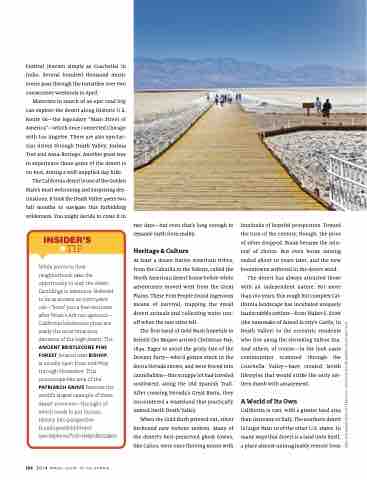Page 168 - 2014 Travel Guide to California
P. 168
Festival (known simply as Coachella) in
Indio. Several hundred thousand music
lovers pass through the turnstiles over two
consecutive weekends in April.
Motorists in search of an epic road trip
can explore the desert along Historic U.S.
Route 66—the legendary “Main Street of
America”—which once connected Chicago
with Los Angeles. There are also spectac-
ular drives through Death Valley, Joshua
Tree and Anza-Borrego. Another great way
to experience these gems of the desert is
on foot, during a well-supplied day hike.
The California desert is one of the Golden
State’s most welcoming and surprising des-
tinations. It took the Death Valley 49ers two
full months to navigate this forbidding
wilderness. You might decide to cross it in
INSIDER’S
»
TIP
While you’re in their
neighborhood, take the
opportunity to visit the oldest
Earthlings in existence. Believed
to be as ancient as 5,000 years
old—“born” just a few centuries
after Noah’s Ark ran aground—
California bristlecone pines are
easily the most tenacious
denizens of the high desert. The
ANCIENT BRISTLECONE PINE
FOREST, located near BISHOP,
is usually open from mid-May
through November. This
moonscape-like area of the
PATRIARCH GROVE features the
world’s largest example of these
desert survivors—the sight of
which tends to put human
history into perspective.
fs.usda.gov/detail/inyo/
specialplaces/?cid=stelprdb5129900
166 2014 T R AV E L G U I D E T O C A L I F O R N I A
two days—but even that’s long enough to
separate myth from reality.
Heritage & Culture
At least a dozen Native American tribes,
from the Cahuilla to the Yokuts, called the
North American desert home before white
adventurers moved west from the Great
Plains. These First People found ingenious
means of survival, trapping the small
desert animals and collecting water run-
off when the rare rains fell.
The first band of Gold Rush hopefuls to
behold the Mojave arrived Christmas Day,
1849. Eager to avoid the grisly fate of the
Donner Party—who’d gotten stuck in the
Sierra Nevada snows, and were forced into
cannibalism—this scrappy lot had traveled
southwest, along the Old Spanish Trail.
After crossing Nevada’s Great Basin, they
encountered a wasteland that practically
named itself: Death Valley.
When the Gold Rush petered out, silver
beckoned new fortune seekers. Many of
the desert’s best-preserved ghost towns,
like Calico, were once thriving mines with
hundreds of hopeful prospectors. Toward
the turn of the century, though, the price
of silver dropped. Borax became the min-
eral of choice. But even borax mining
ended about 10 years later, and the new
boomtowns withered in the desert wind.
The desert has always attracted those
with an independent nature. For more
than 160 years, this rough but complex Cal-
ifornia landscape has incubated uniquely
hardscrabble settlers—from Walter E. Scott
(the namesake of famed Scotty’s Castle, in
Death Valley) to the eccentric residents
who live along the shrinking Salton Sea.
And others, of course—in the lush oasis
communities scattered through the
Coachella Valley—have created lavish
lifestyles that would strike the early set-
tlers dumb with amazement.
A World of Its Own
California is vast, with a greater land area
than Germany or Italy. The southern desert
is larger than 10 of the other U.S. states. In
many ways that desert is a land unto itself,
a place almost unimaginably remote from
JORG HACKEMANN/SHUTTERSTOCK. OPPOSITE:WILDNERDPIX/SHUTTERSTOCK


